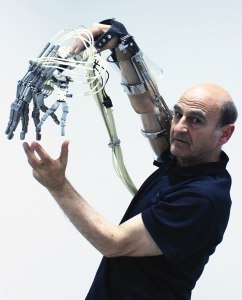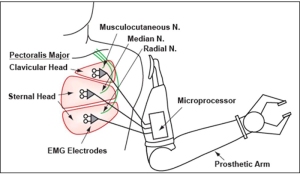The work that sparked the most interest in me was Stelarc’s projects on the human body: Exoskeleton, Ping Body, Fractal Flesh, and Third Arm. I group these projects together because they creatively prompt discourse about prosthetic augmentation, cyborgs, and the idea of human body redesigning. These issues are of great interest to me because I would like to be involved in the research of neural implants and brain machine interfaces and I feel that Stelarc’s projects raise exposure and interest to these types of technological advances and their limitations and implications.
 Stelarc is an Australian performance artist who captured public attention with his suspension performances. His project Third Hand took place between 1980-1998 in locations spreading from Japan and Australia to Europe and the US. His goal for this project was to present “a prosthesis not as a sign of lack, but rather a symptom of excess”. He didn’t want to bring exposure to the technological advances surrounding prosthetics; he wanted to shift the perception of prosthetics from a “replacement” to an “extension”. His performances consisted of demonstrations of the prosthetic hand in action.
Stelarc is an Australian performance artist who captured public attention with his suspension performances. His project Third Hand took place between 1980-1998 in locations spreading from Japan and Australia to Europe and the US. His goal for this project was to present “a prosthesis not as a sign of lack, but rather a symptom of excess”. He didn’t want to bring exposure to the technological advances surrounding prosthetics; he wanted to shift the perception of prosthetics from a “replacement” to an “extension”. His performances consisted of demonstrations of the prosthetic hand in action.
The prosthetic arm used in the performance was based on a prototype developed at Waseda University and was constructed with the assistance of Imasen Nagoya. It’s engineering resembles modern prosthetic limbs. Movement of the mechanical arm is controlled by discrete muscle contractions. An amputee would implement non functional muscles to control the mechanical arm (for example a shoulder level amputee would use its pectoral muscles to trigger movements on the prosthetic arm) but Stelarc uses abdominal and leg muscles to independently control different movements of the mechanical arm. Muscle contractions are picked up by electromyograms, then processed by a computer, and finally transmitted to the prosthetic limb to activate spe cific movements. The diagram to the left demonstrates the same principle in an arm amputee. The prosthetic hand is constructed out of aluminum, stainless steel, acrylic, latex, and associated electronics. It can perform varied movements; pinch release motions, wrist rotation, individual finger movements, and it can transmit tactile feedback.
cific movements. The diagram to the left demonstrates the same principle in an arm amputee. The prosthetic hand is constructed out of aluminum, stainless steel, acrylic, latex, and associated electronics. It can perform varied movements; pinch release motions, wrist rotation, individual finger movements, and it can transmit tactile feedback.
Stelarc’s Third Hand project, in junction with Exoskeleton, Ping Body, and Fractal Flesh, prompts the audience to think about the boundaries that our body places on us and how we can break away from these. For instance, Exoskeleton and Third Hand are body augmentation projects that expose the capabilities of our symbiotic relationships with computerized systems, the possibility of mechanically redesigned bodies, the limits of our biological bodies, and the evolution of the human body mediated by technology instead of random mutation. Furthermore, the Third Hand project repurposes technology mainly developed for amputee victims and gives it new implications. He pushes the idea that we should not limit technological implants to mimic lost functions but also to enhance or enable new ones. In my opinion, this will slowly erase the negative connotation of redesigning the human body. Ping Body and Fractal flesh reinforce the idea of the human body as limiting by proposing a multiplicity of bodies. It presents ideas of individuals with the capabilities of acting on a body remotely. If this is further developed tele-services would prove to be of great use (for instance specialized medical attention in remote areas like a space station or a secluded community).
Rodolfo Antonio Salido Benítez
Yes. It makes me curious what kinds of experiences these produce for him as he uses them–comfort, estrangement, alientation, empowerment..
LikeLike